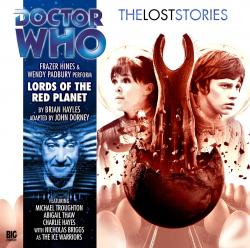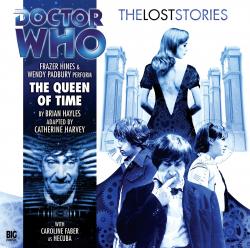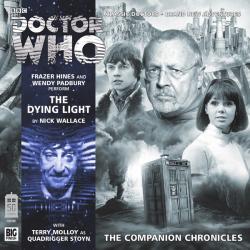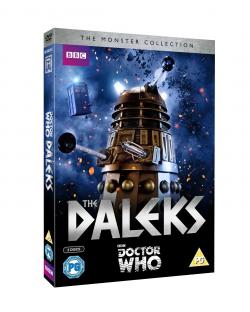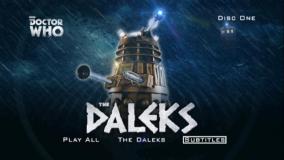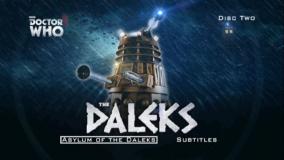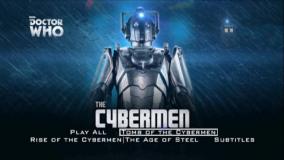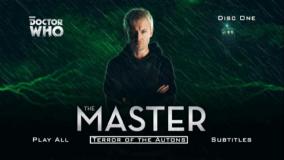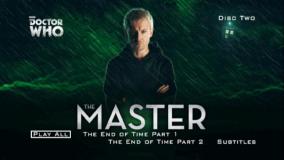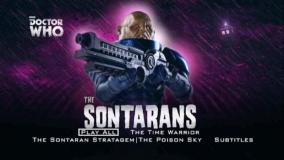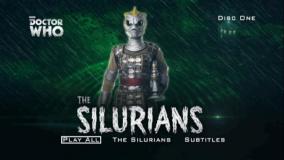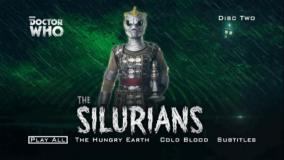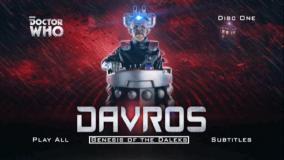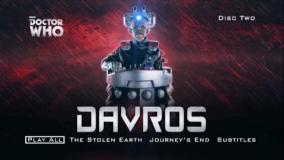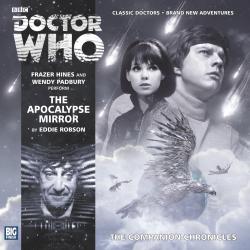The Underwater Menace
The Underwater Menace
Written by Geoffrey Orme
Directed by Julia Smith
Released by BBC Worldwide, 26th October 2015 (R2)
The Episodes
It turns out episodes one and four are telesnap reconstructions in the very strictest sense of the word - they are literally just the telesnaps, shown in progression - including those taken of the opening and closing credits! So, for episode one the opening title music plays over the "Doctor Who" logo, and the closing music plays over an image of a fish-person (plus the producer/director credit telesnaps at the end). The static images also lead to some strange imagery, such as when Zaroff is first introduced you might be led to believe he was a shark!
The reasoning behind why BBC Worldwide decided to present the story in this way is really quite mystifying, especially as their previous effort with The Web of Fear episode three was a much more fluid reconstruction. One can only assume that the budget was so restrictive for this release that they couldn't afford to utilise imagery more appropriate to reflect who/what is on screen, let alone insert the censor clips recovered from Australia, incorporate the standard opening title sequence or recreate the end credits! However, it does mean that you can see the Cura telesnaps in all their glory ...
The soundtrack itself is a clean, un-narrated version. For collectors like myself this is actually quite a good thing, as previously we only have the Anneke Wills-narrated soundtrack version to listen to. However, in terms of presentation the narrated version would probably have made more sense to assist in explaining what is going on, especially with the static telesnap presentation where there are long sequences stuck on a single unreprestative frame.
Overall, I'm not too sure how I feel about the presentation of these episodes; on the one hand it does (just about) serve the purpose of telling the story, but if you are unfamiliar with these episodes then it might well be quite confusing to follow the plot, especially where there is no dialogue - in those cases you might be better off muting the TV and playing the narrated soundtrack alongside the images on screen (or perhaps not even bothering with that as so little is occuring on screen!)
Of course the real reason we're here is the chance to finally see Episode Two in all its glory! With the exception of the lucky attendees at its unveiling at Missing Believed Wiped in December 2011 and a couple of special presentations around the country, the majority of fans have been unable to see the recovered episode for nigh on four years - indeed, we got to see both The Enemy of the World and The Web of Fear beforehand! But was the wait actually worth it?
Episode Three has been available to us for many years of course, and perhaps familiarity has bred contempt, often leading to the story being derided for its outlandish characters, madcap chases, not to mention that immortal final line from Zaroff. With all that baggage, the second episode, therefore, was always going to have a fight on its hands to raise the story from being seen as a 'farce' to something more 'sensible'. However, it wasn't much of a fight in the end - from the outset we are presented with a terrifying scene of Polly about to be operated upon, and then to a much calmer, thoughtful, insightful version of the Doctor to the one seen in the latter episode. I woudn't say that this necessarily immediately raises episode three and the overall story into (ahem) 'classic' status, but in context it now makes the latter episode feel like a 'normal' part three as opposed to the extra prominence placed upon it as being the sole representative of the story.
The problem with a "new" episode is often that there's too much to take in on the first viewing, not to mention the excitement of seeing it that first time. It's the second viewing that normally gives you the chance to better appraise it, and also whether it stands up to the closer scrutiny. Episode two does manage to pass that test, which to me at least means it has been worth the (extended) wait to see it. Though the narrated soundtrack and exisiting telesnaps mean I'm not entirely unfamilar with it, unless we are extremely lucky with when Cura took his shot much of the time little nuances within a scene are lost. Good examples are when we can now see the Doctor's reaction to Zaroff's outrageous claims, or his miming the professor's insanity to Thous, things that weren't evident before. Another one I like is the Doctor hiding in a plain and common wardrobe - in this case there are telesnaps showing this, but they don't quite portray the humour that is present.
I don't think the episode quite meets the hype that has grown up around it being the one remaining episode left to be released for this era of Doctor Who, and it was (justifiably) eclipsed by the two Season Five returns, but all-in-all it isn't a particularly bad episode and probably more representative of the story as a whole. It also now has the 'honour' of being the earliest complete episode of the Troughton era, and means the second Doctor no longer has an 'embarassing' start to his visible adventures!
As a little bonus, those who sit through the end of the episode four credits can find the telesnap credits featured over video of the story's location, Winspit Quarry, which unfortunately only features in the two missing episodes. Not quite a "Now and Then" feature, and the footage hails from A Fishy Tale, but welcome nonetheless!
Special Features
Fortunately, one of the revelations of the formal DVD announcement was that, unlike Enemy and Web, it would (most of) the special features that we are used to on 'classic' series releases. These also included the two (brief) Australian censor clips that weren't incorporated into the reconstructed episodes above, so at least these can still be seen on the DVD.
A Fishy Tale covers the making of the story, looking into the 'mountainous' production journey undertaken by The Underwater Menace from its original inception as Under The Sea, its rejection as unmakable by its original director Hugh David and a 007 film crewmember(!), its removal and subsequent re-instatement to the production schedule as other scripts fell by the wayside, and its ultimate tackling by the previous year's The Smugglers director Julia Smith. Regular companion Anneke Wills provided the main 'commentary' on how the story was produced, with additional insight from Frazer Hines on his formal arrival as Jamie as new companion (and the script adjustments needed to cater for another TARDIS traveller). Other contributors include Catherine Howe who played Ara, assistant floor manager Gareth Gwenlan, and new series writer Robert Shearman giving his take on viewing the story in 'modern times'. The feature was narrated by Peter Davison, who only really started to get his teeth into the special features range through its director Russell Minton, who also provided another welcome touch in the inclusion of especially shot footage out on the story's original locations at Winspit, featuring 'fish-people' out on the beach and in the quarry.
As with the majority of behind-the-scenes features in the Doctor Who DVD range, A Fishy Tale nicely summarises the making of the story, but sadly the nitty-gritty details of the ins-and-outs provided by production information subtitles are not included with this release. Being that these traditionally carry lots of interesting snippets about how the script progressed and changed, what was happening around and during production, etc., it feels like there's a bit of a vacuum this time around, and we are missing out on the usual 'definitive' story of production. I guess we will need to wait for the eventual release of the relevant edition of The Complete History now for that account.
However, at least we have the commentaries to listen to, which provide traditional behind-the-scenes 'gossip'. As with previous incomplete story releases, the existing episodes have the regular cast/crew reminiscences on production, with the missing episodes used to present contextual interviews, clips, etc. For The Underwater Menace, episode one takes the form of the second part of an interview by moderator Toby Hadoke with Patrick Troughton's son Michael (recorded prior to his own inaugural appearance in Last Christmas), who candidly discusses life growing up with his father, his relationships and attitudes towards the work he undertook. The second episode features Anneke Wills, Frazer Hines, Catherine Howe, sound composer Brian Hodgson and floor assistant Quention Mann, and as might be expected discussion focussed on the return of this episode after a few decades and how they felt about being able to see it again. Other tidbits along the way include Frazer commenting on how Colin Jeavons aka Damon's eyebrows reminded him of an androgum (with Toby observing no colour photos exist to compare against), and how the opening scenes of the story raised concern over children not wanting flu jabs. Moving onto the third episode, anecdotes included reflections on the challenges faced both for and with director Julia Smith, the 'infamous' way in which Joseph Furst played Zaroff, plus Brian on the difficulties of sound mixing in the early days and Anneke on Troughton's thoughts over 'that' scene with the fish-people ... The last episode is made up of archive recordings, and features Julia Smith and the originally-slated director Hugh David on making (and not making) the story, producer Innes Lloyd on what he liked about producing Doctor Who and the changes of direction he instigated, and a longer interview with the Doctor himself, Patrick Troughton in which he talks about getting and creating the role, costume and "hairy" arrangements, and how important a routine was for making such a frenetic show.
Yvette Fielding is back for the second half of The Television Centre of the Universe - and we also get a "previously" which is quite useful if you haven't watched the first half since it's release on The Visitation in 2013. The "cliff-hanger" is resolved to be cameraman Alec Wheal, and then it's straight into anecdotes between him and the trio of Peter Davison, Janet Fielding and Mark Strickson about life in the studio during recording (plus BBC producer/fan Richard Marson chatting about the "fan glitterati" who watched whatever they could studio galleries!). As before, the main conversations were interspersed with anecdotes from other production personnel, such as assistant floor manager Sue Hedden on how props could disappear and exhibitions assistant Bob Richardson admitting he had purloined a terileptil mind control device! Other contributors included production assistant Jane Ashford (who reflected on the challenges of maintaining contunuity during filming) and videotape engineer Simon Anthony (who commented on combatting recording issues from lighting and physical effects). It was also an unexpected bonus to see behind-the-scenes footage from Earthshock to help illustrate the discussion!
As with the previous part, this is a relaxed, light-hearted wander through the production process and a way to 'look' around TVC as-was, before its tragic final closure. And, in tradition, it's off to the BBC Bar to finish off both this production and (possibly) the classic Doctor Who DVD feature range as a whole!
Conclusion
Overall, the story is quite a jolly romp. We get to see Patrick Troughton portray a more playful and extravagant version before these elements are toned down into the more focussed, enigmatic Doctor we travel alongside in later adventures. We get the over-the-top mad Professor Zaroff played with gusto by Joseph Furst. And of course we get to see the companion triad of Ben, Polly and Jamie in action for the first time. Visually, there are some impressive sets, and I personally think the fish people "showcase" in episode three is quite an effective scene (not to mention giving Dudley Simpson a good run for his money!). However, the story is hardly a memorable classic like many of the era to come - it's certainly not the best story in the world, but then again it is also by no means the worst in the grand history of Doctor Who.
In terms of the DVD itself, it's a shame that the still missing episodes were presented in such a basic form, but to misquote a well-known BBC phrase, "other viewing methods are available!" It's also disappointing that the production subtitles were not included, but on the other hand it is great to finally be able to see the second episode fully restored, the making-of, and the final part of the TV Centre feature.
Coming Soon ...
Sadly, "Nothing left in the world has stopped us now..."
